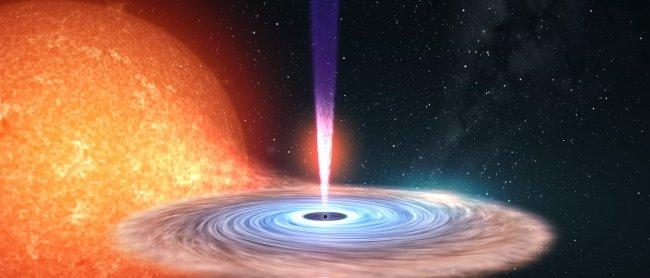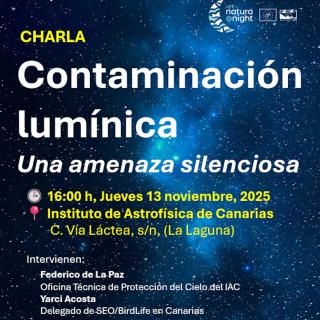A stellar mass black hole is a compact object with a mass greater than 3 solar masses. It is so dense and has such a powerful force of attraction that not even light can escape from it. That is why it cannot be observed directly, but only via the effects in produces, in the present case on its companion star, from which it “feeds”. In general when matter falls onto a black hole is does so “quietly” by way of an accretion disc. However there are periods when this in fall is violent, and “bursty”, producing a strong outburst of X-ray brightness.
Binary systems composed of a star donating mass to a black hole are essential laboratories for the understanding of the most extreme physical phenomena in the universe. , such as those which, towards the end of the life of a massive star lead to the formation of the black hole itself, or to a neutron star. Until now some 60 candidates for this type of black holes have been found in our Galaxy, thanks to the detection of transient eruptions of X-rays, but only 17 of these have been confirmed. This is because of the difficulties in the way of studying the motion of the companion star round the black hole, which would allow us to infer its mass, and confirm the type of object.
Researchers have only a limited knowledge of the formation and the evolution of this type of objects, because of the small number of known binaries containing a black hole. That is why it is important to develop new strategies which will let us discover the “hidden”· population of the Galaxy, that is those objects which are “hibernating” , not in an active phase, and so are not emitting X-rays.
The IAC researchers Jorge Casares, and Miguel A. Pérez Torres have tested a novel technique measuring the brightness of these binary pairs with a combination of filters centred on the line of hydrogen Halpha. The measurements give information about the intensity and the width of this line, which forms inteh accretion disc around the black hole. In particular, the width of Halpha can be used as an indicator of the strength of the gravitational field, and so can be used as a diagnostic of the presence of a black hole. This technique could reveal, very efficiently, new black hole binaries in an inactive phase.
To show this they observed 4 systems with confirmed black holes using a set of special filters on ACAM, an instrument on the 4.2m William Herschel Telescope (WHT) of the Isaac Newton group of Telescopes at the Roque de los Muchachos Observatory (Garafía, La Palma). The results were then compared with direct measurements of the width of the Halpha line obtained with the ISIS spectrograph on the Gran Telescopio de Canarias (GTC). The result showed that it is practical to measure the width of the Halpha line using photometric techniques, which opens the door to a more efficient detection of inactive black holes in binary systems.
They estimate that an analysis of some 1000 square degrees (10%) of the zone of the Galactic plane with this strategy should detect at least 50 new objects of this type, which is three times the currently known population. This search could also yield a detailed census of other Galactic populations, such as short period cataclysmic variables, X-ray binaries containing neutron stars, and ultra-compact binaries with period shorter than one hour.
Scientific aticles:
J. Casares, M.A.P. Torres, 2018, "A feasibility study on the photometric detection of quiescent black hole X-ray binaries", MNRAS, 481, 4372. DOI: 10.1093/mnras/sty2570
J. Casares, 2018, "Hibernating black holes revealed by photometric mass functions", MNRAS, 473, 5195. DOI: 10.1093/mnras/stx2690
Press release - Isaac Newton Group of Telescopes: http://www.ing.iac.es/PR/press/BHXBs.html



